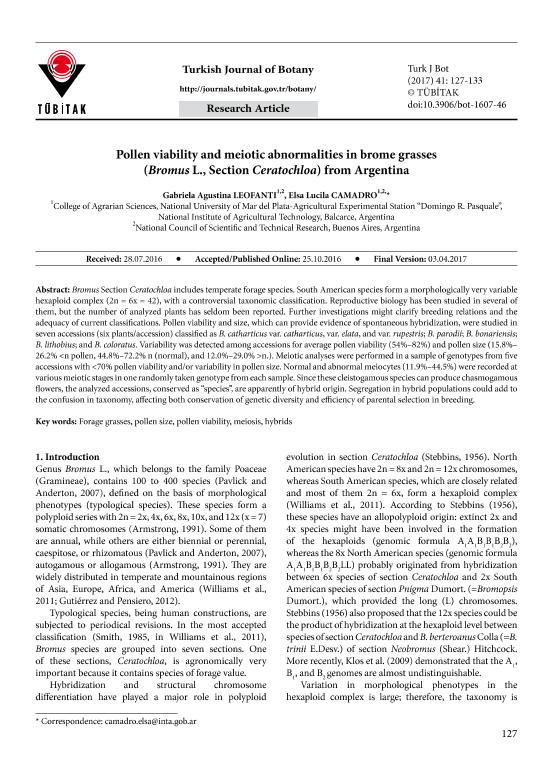Artículo
Pollen viability and meiotic abnormalities in brome grasses (Bromus L., section Ceratochloa) from Argentina
Fecha de publicación:
10/2016
Editorial:
Tubitak Scientific & Technical Research Council Turkey
Revista:
Turkish Journal of Botany
ISSN:
1300-008X
e-ISSN:
1303-6106
Idioma:
Inglés
Tipo de recurso:
Artículo publicado
Clasificación temática:
Resumen
Bromus Section Ceratochloa includes temperate forage species. South American species form a morphologically very variable hexaploid complex (2n = 6x = 42), with a controversial taxonomic classification. Reproductive biology has been studied in several of them, but the number of analyzed plants has seldom been reported. Further investigations might clarify breeding relations and the adequacy of current classifications. Pollen viability and size, which can provide evidence of spontaneous hybridization, were studied in seven accessions (six plants/accession) classified as B. catharticus var. catharticus, var. elata, and var. rupestris; B. parodii; B. bonariensis; B. lithobius; and B. coloratus. Variability was detected among accessions for average pollen viability (54%–82%) and pollen size (15.8%– 26.2% n.). Meiotic analyses were performed in a sample of genotypes from five accessions with <70% pollen viability and/or variability in pollen size. Normal and abnormal meiocytes (11.9%–44.5%) were recorded at various meiotic stages in one randomly taken genotype from each sample. Since these cleistogamous species can produce chasmogamous flowers, the analyzed accessions, conserved as “species”, are apparently of hybrid origin. Segregation in hybrid populations could add to the confusion in taxonomy, affecting both conservation of genetic diversity and efficiency of parental selection in breeding.
Palabras clave:
FORAGE GRASSES
,
HYBRIDS
,
MEIOSIS
,
POLLEN SIZE
,
POLLEN VIABILITY
Archivos asociados
Licencia
Identificadores
Colecciones
Articulos(CCT - MAR DEL PLATA)
Articulos de CTRO.CIENTIFICO TECNOL.CONICET - MAR DEL PLATA
Articulos de CTRO.CIENTIFICO TECNOL.CONICET - MAR DEL PLATA
Citación
Leofanti, Gabriela Agustina; Camadro, Elsa Lucila; Pollen viability and meiotic abnormalities in brome grasses (Bromus L., section Ceratochloa) from Argentina; Tubitak Scientific & Technical Research Council Turkey; Turkish Journal of Botany; 41; 2; 10-2016; 127-133
Compartir
Altmétricas




